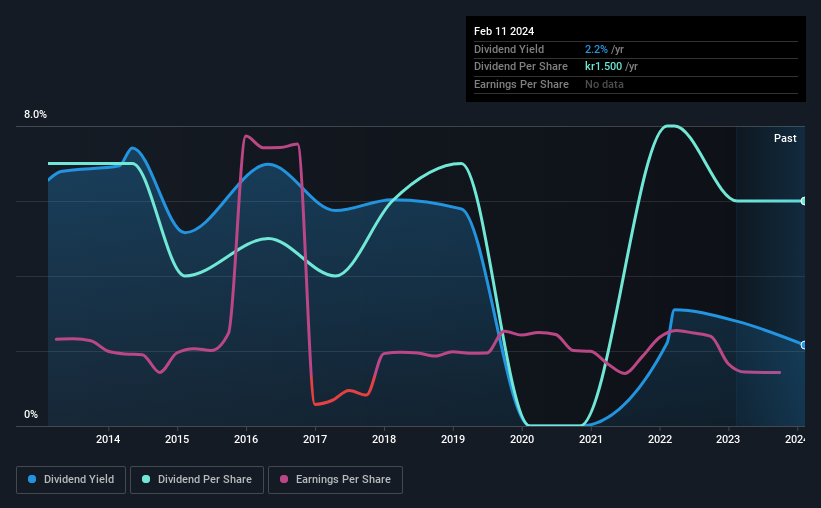Polaris Media (OB:POL) Is Paying Out Less In Dividends Than Last Year
The board of Polaris Media ASA (OB:POL) has announced it will be reducing its dividend by 33% from last year's payment of NOK1.50 on the 1st of January, with shareholders receiving NOK1.00. Based on this payment, the dividend yield will be 2.2%, which is lower than the average for the industry.
While the dividend yield is important for income investors, it is also important to consider any large share price moves, as this will generally outweigh any gains from distributions. Investors will be pleased to see that Polaris Media's stock price has increased by 34% in the last 3 months, which is good for shareholders and can also explain a decrease in the dividend yield.
View our latest analysis for Polaris Media
Polaris Media Doesn't Earn Enough To Cover Its Payments
It would be nice for the yield to be higher, but we should also check if higher levels of dividend payment would be sustainable. Based on the last payment, the company wasn't making enough to cover what it was paying to shareholders. This situation certainly isn't ideal, and could place significant strain on the balance sheet if it continues.
Looking forward, EPS could fall by 29.6% if the company can't turn things around from the last few years. Assuming the dividend continues along recent trends, we believe the payout ratio could reach 530%, which could put the dividend under pressure if earnings don't start to improve.

Dividend Volatility
The company's dividend history has been marked by instability, with at least one cut in the last 10 years. The dividend has gone from an annual total of NOK1.75 in 2014 to the most recent total annual payment of NOK1.50. This works out to be a decline of approximately 1.5% per year over that time. Generally, we don't like to see a dividend that has been declining over time as this can degrade shareholders' returns and indicate that the company may be running into problems.
The Dividend Has Limited Growth Potential
With a relatively unstable dividend, it's even more important to see if earnings per share is growing. Over the past five years, it looks as though Polaris Media's EPS has declined at around 30% a year. Dividend payments are likely to come under some pressure unless EPS can pull out of the nosedive it is in.
Polaris Media's Dividend Doesn't Look Great
To sum up, we don't like when dividends are cut, but in this case the dividend may have been too high to begin with. The company isn't making enough to be paying as much as it is, and the other factors don't look particularly promising either. Overall, this doesn't get us very excited from an income standpoint.
Market movements attest to how highly valued a consistent dividend policy is compared to one which is more unpredictable. However, there are other things to consider for investors when analysing stock performance. Just as an example, we've come across 4 warning signs for Polaris Media you should be aware of, and 1 of them is a bit concerning. If you are a dividend investor, you might also want to look at our curated list of high yield dividend stocks.
New: Manage All Your Stock Portfolios in One Place
We've created the ultimate portfolio companion for stock investors, and it's free.
• Connect an unlimited number of Portfolios and see your total in one currency
• Be alerted to new Warning Signs or Risks via email or mobile
• Track the Fair Value of your stocks
Have feedback on this article? Concerned about the content? Get in touch with us directly. Alternatively, email editorial-team (at) simplywallst.com.
This article by Simply Wall St is general in nature. We provide commentary based on historical data and analyst forecasts only using an unbiased methodology and our articles are not intended to be financial advice. It does not constitute a recommendation to buy or sell any stock, and does not take account of your objectives, or your financial situation. We aim to bring you long-term focused analysis driven by fundamental data. Note that our analysis may not factor in the latest price-sensitive company announcements or qualitative material. Simply Wall St has no position in any stocks mentioned.
About OB:POL
Polaris Media
Operates as a media house and printing company in Norway and Sweden.
Excellent balance sheet second-rate dividend payer.
Market Insights
Community Narratives



